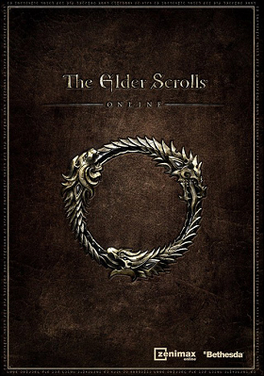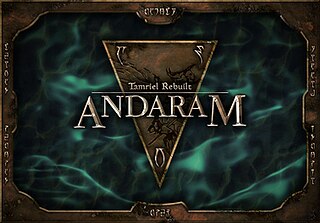The Elder Scrolls is a series of action role-playing video games primarily developed by Bethesda Game Studios and published by Bethesda Softworks. The series focuses on free-form gameplay in an open world. Most games in the series have been critically and commercially successful, with The Elder Scrolls III: Morrowind (2002), The Elder Scrolls IV: Oblivion (2006) and The Elder Scrolls V: Skyrim (2011) all winning Game of the Year awards from multiple outlets. The series has sold more than 59 million copies worldwide.

The Elder Scrolls III: Bloodmoon is the second expansion pack for the 2002 video game The Elder Scrolls III: Morrowind, developed by Bethesda Game Studios and released for Windows in 2003. The expansion was later released as part of the Morrowind: Game of the Year Edition for the Xbox in 2004. The expansion adds a landmass to the game, Solstheim, a setting modelled on Norse mythology. The primary questline of Bloodmoon involves the investigation of the Bloodmoon Prophecy that foretells the return of the demigod Hircine. A secondary features a new faction, the East Empire Company, which tasks the player to establish a mining colony. Bloodmoon also provides the player with the ability to become a werewolf, a feature closely embedded in the main storyline and quests. The expansion features more detailed environments, including weather shaders such as snowfall and blizzards.

An Elder Scrolls Legend: Battlespire is an action role-playing video game developed and published by Bethesda Softworks, set in the world of The Elder Scrolls.

The Elder Scrolls III: Morrowind is a 2002 action role-playing game developed by Bethesda Game Studios and published by Bethesda Softworks. It is the third installment in The Elder Scrolls series, following 1996's The Elder Scrolls II: Daggerfall, and was released for Microsoft Windows and Xbox. The main story takes place on Vvardenfell, an island in the Dunmer province of Morrowind, part of the continent of Tamriel. The central quests concern the demigod Dagoth Ur, housed within the volcanic Red Mountain, who seeks to gain power and break Morrowind free from Imperial reign.

The Elder Scrolls IV: Oblivion is a 2006 action role-playing game developed by Bethesda Game Studios, and co-published by Bethesda Softworks and 2K Games. It is the fourth installment in The Elder Scrolls series, following 2002's The Elder Scrolls III: Morrowind, and was released for Microsoft Windows and Xbox 360 in 2006, followed by PlayStation 3 in 2007. Taking place within the fictional province of Cyrodiil, the game's main story focuses on the player character's efforts to thwart a fanatical cult known as the Mythic Dawn that plans to open portal gates to a demonic realm known as Oblivion.

The Elder Scrolls: Arena is an open-world action role-playing video game developed and published by Bethesda Softworks. The first game in the Elder Scrolls series, it was released for MS-DOS on March 25, 1994. The game follows the player trying to uncover a conspiracy against Emperor Uriel Septim VII.

The Elder Scrolls II: Daggerfall is an open-world, action role-playing game published by Bethesda Softworks. The second video game in the Elder Scrolls series, it was released on September 20, 1996 for MS-DOS, following the success of 1994's The Elder Scrolls: Arena. The story follows the player, sent by the Emperor, to free the ghost of King Lysandus from his earthly shackles and discover what happened to a letter sent from the Emperor to the former queen of Daggerfall.

Todd Andrew Howard is an American video game designer, director, and producer. He serves as director and executive producer at Bethesda Game Studios, where he has led the development of the Fallout and The Elder Scrolls series. He was also the game director for Starfield.

The Elder Scrolls IV: Shivering Isles is the second expansion pack for the role-playing video game The Elder Scrolls IV: Oblivion. Announced on January 18, 2007, the expansion was developed, published, and released over the Xbox Live Marketplace by Bethesda Softworks; its retail release was co-published with 2K Games. It was released for Microsoft Windows in a boxed retail edition on March 26, 2007, while the Xbox 360 version was released digitally on the Xbox Live Marketplace. Shivering Isles takes place on the eponymous isles ruled by the Daedric Prince of Madness, Sheogorath. The player becomes Sheogorath's protégé, and together they try to defeat the Daedric Lord of Order, Jyggalag, thus preventing the isles from being destroyed; this main quest can be ignored for as long as the player wishes to interact with the new world. It is often considered to be Bethesda's best expansion, as well as one of the best expansions in video game history.

The development of The Elder Scrolls IV: Oblivion began in 2002, immediately after its predecessor, The Elder Scrolls III: Morrowind, was published. Rumors of a sequel to Morrowind started circulating in June 2004; the sequel's title was identified on September 10, 2004, the date of its official announcement. Oblivion was developed by Bethesda Game Studios, and the initial Xbox 360 and personal computer (PC) releases were co-published by Bethesda Softworks and Take-Two Interactive's subsidiary, 2K Games. According to interviews with Bethesda staff, the publisher-developer relationship—one of the few independent relations in the industry—worked well, and Bethesda was not subject to excessive corporate guidance. Initially scheduled for a November 22, 2005, release, in tandem with the Xbox 360's launch, Oblivion was delayed to a March 21, 2006, release for Windows PCs and the Xbox 360.
Eon Digital Entertainment was a computer games publishing company based in London, UK, operating globally. It was founded by John Burns, now of Electronic Arts and a former Managing Director of Activision Europe as well as senior management figure at Atari, Sega and Bandai. Other management included Sara Pelton of Ubisoft&Activision, James Cato of Take 2 Interactive and several other experienced industry management figures.
Emil Pagliarulo is an American video game designer who works at Bethesda Game Studios.

The Elder Scrolls V: Skyrim is a 2011 action role-playing game developed by Bethesda Game Studios and published by Bethesda Softworks. It is the fifth main installment in The Elder Scrolls series, following The Elder Scrolls IV: Oblivion (2006), and was released worldwide for Microsoft Windows, PlayStation 3, and Xbox 360 on November 11, 2011.

Creation Engine is a 3D video game engine created by Bethesda Game Studios based on the Gamebryo engine. The Creation Engine has been used to create role-playing video games such as The Elder Scrolls V: Skyrim, Fallout 4, and Fallout 76. A new iteration of the engine, Creation Engine 2, was used to create Starfield. The Creation Engine has been tailor-made for large-scale open-world RPGs.

The Elder Scrolls Online, abbreviated ESO, is a massively multiplayer online role-playing game (MMORPG) developed by ZeniMax Online Studios and published by Bethesda Softworks. The game is a part of the Elder Scrolls series. It was released for Windows and macOS in April 2014, for PlayStation 4 and Xbox One in June 2015, and for PlayStation 5 and Xbox Series X/S in June 2021.

The Elder Scrolls V: Skyrim – Dragonborn is the third and final add-on for the action role-playing open world video game The Elder Scrolls V: Skyrim. It was developed by Bethesda Game Studios and released by Bethesda Softworks on the Xbox Live Marketplace on December 4, 2012. The Microsoft Windows version was released on February 5, 2013, and the PlayStation 3 version was released on February 12, 2013.
Mark Nelson is an American video game designer and humor writer best known for his work with Bethesda Game Studios and the game series The Elder Scrolls. In March 2007, he joined computer games company Big Huge Games to create a new role-playing game, joining industry veteran Brian Reynolds and long-time collaborator Ken Rolston.

Tamriel Rebuilt is a third-party modification for the Bethesda Softworks 2002 role-playing video game The Elder Scrolls III: Morrowind. Founded in 2001, the Tamriel Rebuilt project is a long-term, collaborative effort by volunteer modders to expand the content of Morrowind to include wider settings consistent with the setting of the Elder Scrolls' universe of Tamriel. Since foundation, the project has published eight releases for Morrowind, described as 'expansions', that allow the player to travel to and explore the mainland of the province of Morrowind, featuring new factions and quests. In 2006, Tamriel Rebuilt briefly launched a secondary project to recreate the province of Hammerfell in the succeeding Elder Scrolls game, The Elder Scrolls IV: Oblivion, although the project was cancelled in 2009. Publications have praised Tamriel Rebuilt for the scope and detail of the project, the faithfulness of its additions to the source material of the original game, and noted their content has since eclipsed the size and features of the original game. The current release, Andaram, was published on 31 October 2023.















